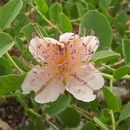Distribution in Egypt
provided by Bibliotheca Alexandrina LifeDesk
Oases, Egyptian desert, Sinai (St.Katherine), eastern desert, Mediterranean region and western desert.
- author
- BA Cultnat
- provider
- Bibliotheca Alexandrina
Global Distribution
provided by Bibliotheca Alexandrina LifeDesk
Mediterranean region, west and central Asia to India.
- author
- BA Cultnat
- provider
- Bibliotheca Alexandrina
Life Expectancy
provided by Bibliotheca Alexandrina LifeDesk
- author
- BA Cultnat
- provider
- Bibliotheca Alexandrina
Comments
provided by eFloras
Camel and goats graze on it and the fruits and buds sometimes pickled.
A very variable species and the status of various varieties described under it, from time to time, is very doubtful. However, in Sind, where the plants were observed in field, two forms, one prostrate or sprawling with larger leaves and the other with erect habit and smaller elliptical leaves, were present. How far these habits are constant is still to be worked out.
- license
- cc-by-nc-sa-3.0
- copyright
- Missouri Botanical Garden, 4344 Shaw Boulevard, St. Louis, MO, 63110 USA
Description
provided by eFloras
Diffuse shrub, prostrate or hanging, glabrous or pubescent. Leaves very variable in size and shape with a length/breadth ratio of 1-1.7, usually about one and a half times as long as broad, ovate, obovate, orbicular to elliptic, 1-4 cm long, 1-3.5 cm broad, entire, acute, obtuse, retuse or slightly acuminate; apex mostly spine-tipped; petiole up to 4 mm long; stipules of 2 hooked rarely straight, brown or yellow coloured spines. Flowers axillary and solitary, 2-5 cm across, sub-irregular, handsome, whitish; pedicels 2-6 (-9) cm long, becoming thickened in fruit. Sepals subequal, posterior sepal not galeate, 1-2 cm long, broadest at the base and only 3-4.5 mm deep near the apex. Petals 1.5-3 cm long, 0.6-2 cm broad, obovate-cuneate, exceeding the sepals. Stamens indefinite, exceed¬ing the petals, spreading; anthers 1-2.5 mm long. Fruit 1.5-4.5 cm long, 1-1.8 cm broad, ellipsoid or oblong—obovate, often slightly ribbed, red when ripe, often splitting into 4 parts from the apex when dried and pressed; gynophore 3-7 cm long; seeds many, 2-3 mm in diam., brown.
- license
- cc-by-nc-sa-3.0
- copyright
- Missouri Botanical Garden, 4344 Shaw Boulevard, St. Louis, MO, 63110 USA
Distribution
provided by eFloras
Distribution: S. Europe eastward to Australia.
- license
- cc-by-nc-sa-3.0
- copyright
- Missouri Botanical Garden, 4344 Shaw Boulevard, St. Louis, MO, 63110 USA
Brief Summary
provided by EOL authors
Capers are the unopened flower buds of a straggling spiny shrub, Capparis spinosa, in the family Capparaceae. This plant has been known for millennia and is cultivated in the Mediterranean region. Capers grow wild in the Mediterranean region as well as in North Africa and from Turkey west to the Gobi Desert. The buds are pickled in vinegar and used as a condiment; they are also often included in sauces (e.g., tartar sauce) and as a seasoning with raw meat (e.g., steak tartare). The plant has thick leaves, each with a pair of spines at its base. The white or pinkish flowers are 4 to 6 cm across. (Vaughan and Geissler 1997)

